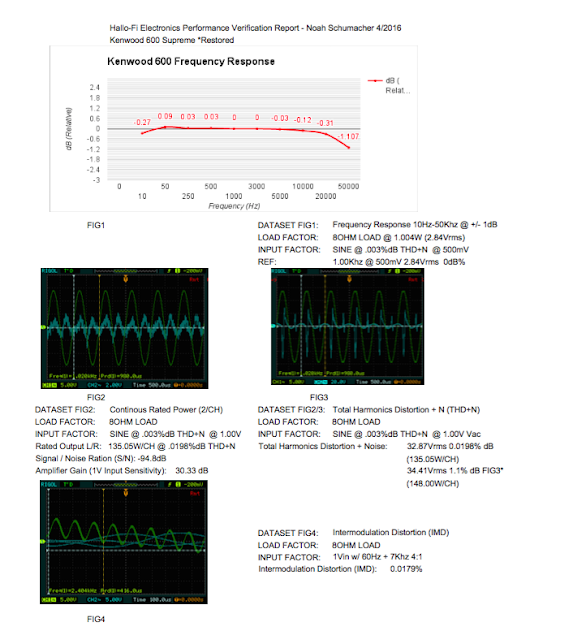Kenwood Model 600 Supreme
Here is another Kenwood Model 600 Supreme we have in for a restoration. The Kenwood 600 is a TOTL variant quietly produced and exported by kenwood-trio. part of the infamous Supreme series, manufactured from 1973 to 1979’ this features the popular dual power supply topography designed by kenwood and later adopted with Kentronics which later produced the Accuphase series. From research it would indicate that their are potentially less than the 1500 or so 600’s out there produced and who knows how many left in good repair.
With an impressive 18,000MFD of filter a side for a total of 72,000MFD of reserve!, the 600 also touts a limited ALPS 44 stepped attenuator and a ALPS coaxial balance fader! The 600 used excessive heatsink platforms and specific shielding channels for input/output leads along with bottom chassis well.
Power Supply X00-1720-10 & Protection X00-1700-20
The dual mono power supply assembly is a slide connected PCB into a molex base at the chassis, supplied with independent 18,000MFD caps. The electrolytic were all replaced with a high temp (105C) long life Nichicon PW and Panasonic FR/FC type with VP 100MFD bi polar capacitors.
Through several variations I was able to correct the 40/28 and 14V output voltages by updating the 2sc1419/2sa755 BJT’s to heavy duty On Semi MJ15/32/33 type TO-220 transistors along with their TO-92 pairs of KSA992/KSC1845 type.
Noted dZ5-9 were updated to general type 1N4148 diodes and the V06B type diode at Dz10 updated to a ultra-fast 4005 type diode. I want to also note that the glue used for the large original 100MFD caps had severally corroded the diode at Dz10 and associated resistors which had to be replaced.
The ProtectionPCB is a dual facet over current detection and excessive offset detection. Protection transistors Q9-11 were all updated to 733/1845 BJT’s. I want to note that pinout for Qz9/10 (733/1845) are different than the PCB topography. Qz11 was updated to a KSC6909AYS class (2SD415) and a new Omron MY2-24V was installed.
The original four 18,000MFD filter capacitors were replaced with a high quality Nippon Chem-Con 18K 75V filter capacitors with adapted screw terminations.
Originals...
New Nippon 18Kmfd
Amplifier Stages X07-1440-00
The driver stage consists of an initial 1st order dual FET package IC differential 2SK58, which is enclosed in its own shielding!, the proceeding second stage differential is comprised of a pair of NPN transistors (front end gain bump). The 2nd order differential were swapped with 1% matched ZTX694 bjt’s (All BJT’s watch pinout*) and 3rd order differentiate KSA1381 type. Major upgrades to the transistor packages should be done as we did here due to their high failure rate at Q6 (2sc1452) to a KSC3503 for the constant current BJT.


All the original bias and especially the offset course/fine post should be replaced, we choose a high quality Bourns precisions multi turn trimmer. All the electrolytic capacitors were replaced with a audio grade Nichicon KA (10MFD) the remaining films were replaced with a high grade WIMA polypropylene .1MFD and a Panasonic ECW high grade polypropylene .01MFD capacitors. One of the prized components in the driver stage is the TO-3s were Sanken 1164/747A output devices capable of a 40A drive(PVP)!, which were removed and MICA/compound applied.
Pre-Amplifier (RIAA) X08-1560-10, Tone Control X11-1310-00 & Filter Assembly X12-1130-10
Unique to the technilogical advances prevalent within the 600, the RIAA stage is comprised entirely of JFET devices. In a 3rd order array the initial FET’s comprise of a Class A differential + drive stage with a constant current regulation. All the original electrolytic were replaced with audio grade Nichicon KA and Fine-Gold capacitors, while 1MFD< were replaced with high grade WIMA polypropylene film capacitors.
The tone stage is designed again around a class front end, using a Shunt-Regulated-Push-Pull (SRPP) configuration using FET’s. (2SK Japanese devices) The Tone and filter assemblies were treated as above, with all electrolytics replaced with audio grade Nichicon KA and high grade WIMA polypropylene film capacitors. The input stage of the filter assembly had the original mylar/poly films upgrade to high grade Panasonic ECW polypropylene type.
Verification Report 4/8 OHM Reports





































